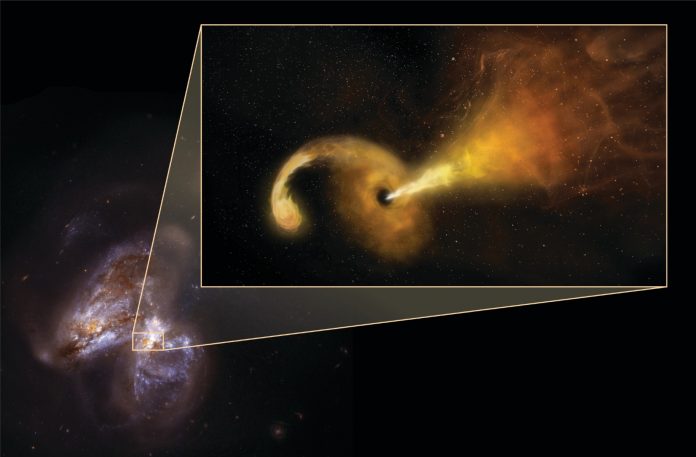Astronomers have, for the first time, captured the moment the gravity of a supermassive black hole ripped apart a star that drifted too close to causing a fast-moving jet of cosmic material and energy to be ejected.
The event took place in a pair of colliding galaxies called Arp 299, nearly 150 million light-years from Earth. At the core of one of the galaxies, a black hole 20 million times more massive than the Sun shredded a star more than twice the Sun’s mass, setting off a chain of events that revealed important details of the violent encounter.
The scientists tracked the event with multiple radio and infrared telescopes from across the world, including the Lovell Telescope at Jodrell Bank Observatory, working as part of the European Very Long Baseline Network (EVN).
Dr Rob Beswick, from the Jodrell Bank Centre for Astrophysics at The University of Manchester’s School of Physics and Astronomy, and co-investigator of this project, said: “This is a fantastic discovery and an extremely important result in astronomy. It is a testament to the persistence of the science team and demonstrates the power of globally coordinated VLBI observations, including multiple telescopes from Jodrell Bank Observatory and the e-MERLIN array in the UK.”
Only a small number of such stellar deaths, called tidal disruption events, or TDEs, have ever been detected. Theorists suggested that material pulled from the doomed star forms a rotating disk around the black hole, emitting intense X-rays and visible light. It also launches jets of material outward from the poles of the disk at nearly the speed of light.
“Never before have we been able to directly observe the formation and evolution of a jet from one of these events,” said Miguel Perez-Torres, of the Astrophysical Institute of Andalucia in Granada, Spain. “Tidal disruption events can provide us with a unique opportunity to advance our understanding of the formation and evolution of jets in the vicinities of these powerful objects,” he added.
Dr Beswick, who is also Head of Science Operations and Support of UK’s e-MERLIN/VLBI National Facility, added: “The discovery came as a surprise. The initial infrared burst was discovered as part of a project that sought to detect supernova explosions in such colliding pairs of galaxies. Arp 299 has seen numerous stellar explosions, and has been dubbed a ‘supernova factory.’ This new object originally was considered to be a supernova explosion.
“Such events may have been more common in the distant Universe, so studying them may help scientists understand the environment in which galaxies developed billions of years ago.”
The discovery has taken over a decade to unravel. The first indication came on January 30, 2005, when astronomers using the William Herschel Telescope in the Canary Islands discovered a bright burst of infrared emission coming from the nucleus of one of the colliding galaxies in Arp 299. On July 17, 2005, the National Science Foundation’s Very Long Baseline Array (VLBA) revealed a new, distinct source of radio emission from the same location.
The researchers then used the Nordic Optical Telescope on the Canary Islands and NASA’s Spitzer space telescope to follow the object’s infrared emission. Continued observations with the EVN, VLBA and other radio telescopes, carried out over nearly a decade, showed the source of radio emission expanding in one direction, just as expected for a jet.
Only in 2011, six years after discovery, the radio-emitting portion began to show an elongation. Subsequent monitoring showed the expansion growing, confirming that what the scientists are seeing is a jet, not a supernova.
These observations used multiple radio-telescope antennas, separated by thousands of miles, to gain the resolving power, or ability to see fine detail, required to detect the expansion of an object so distant. “A global network of collaborating radio antennas is the only way to see this jet structure and study the evolution of such distant objects in detail.” says Eskil Varenius, formerly at Onsala Space Observatory in Sweden, now at Jodrell Bank Centre for Astrophysics in the UK. “It is incredible what these telescope networks can do. This is a clear case where international collaboration achieve a combined whole much greater than the sum of its parts.”







